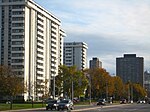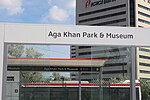Ontario Science Centre
1969 establishments in OntarioAmateur radioAssociation of Science-Technology Centers member institutionsBrutalist architecture in CanadaBuildings and structures completed in 1969 ... and 11 more
Crown corporations of OntarioIMAX venuesMuseums established in 1969Museums in TorontoNorth YorkRaymond Moriyama buildingsScience and technology in TorontoScience centersScience museums in CanadaUse Canadian English from January 2020Use mdy dates from January 2020

The Ontario Science Centre (French: Centre des sciences de l'Ontario), formally the Centennial Museum of Science and Technology, is a science museum in Toronto, Ontario, Canada, near the Don Valley Parkway about 11 kilometres (6.8 mi) northeast of downtown on Don Mills Road just south of Eglinton Avenue East in the former city of North York. It is built down the side of a wooded ravine formed by one branch of the Don River located in Flemingdon Park.
Excerpt from the Wikipedia article Ontario Science Centre (License: CC BY-SA 3.0, Authors, Images).Ontario Science Centre
Don Mills Road, Toronto
Geographical coordinates (GPS) Address Nearby Places Show on map
Geographical coordinates (GPS)
| Latitude | Longitude |
|---|---|
| N 43.716666666667 ° | E -79.338333333333 ° |
Address
Shoppers Drug Mart OMNIMAX Theatre
Don Mills Road
M3C 1T2 Toronto (North York)
Ontario, Canada
Open on Google Maps










